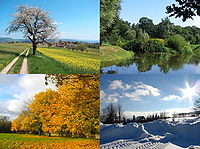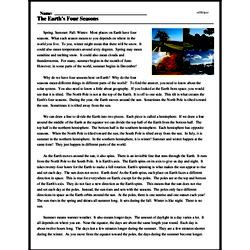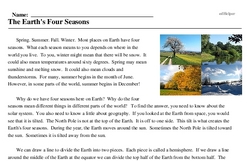The Earth's Four Seasons
Spring. Summer. Fall. Winter. Most places on Earth have four seasons. What each season means to you depends on where in the world you live. To you, winter might mean that there will be snow. It could also mean temperatures around sixty degrees. Spring may mean sunshine and melting snow. It could also mean clouds and thunderstorms. For many, summer begins in the month of June. However, in some parts of the world, summer begins in December!
Why do we have four seasons here on Earth? Why do the four seasons mean different things in different parts of the world? To find the answer, you need to know about the solar system. You also need to know a little about geography. If you looked at the Earth from space, you would see that it is tilted. The North Pole is not at the top of the Earth. It is off to one side. This tilt is what creates the Earth's four seasons. During the year, the Earth moves around the sun. Sometimes the North Pole is tilted toward the sun. Sometimes it is tilted away from the sun.
We can draw a line to divide the Earth into two pieces. Each piece is called a hemisphere. If we draw a line around the middle of the Earth at the equator we can divide the top half of the Earth from the bottom half. The top half is the northern hemisphere. The bottom half is the southern hemisphere. Each hemisphere has opposite seasons. When the North Pole is tilted toward the sun, the South Pole is tilted away from the sun. In July, it is summer in the northern hemisphere. In the southern hemisphere, it is winter! Summer and winter happen at the same time! They just happen in different parts of the world.




